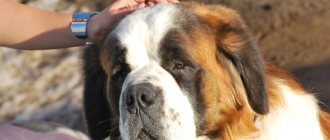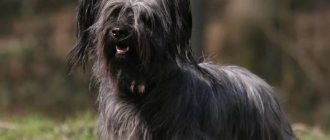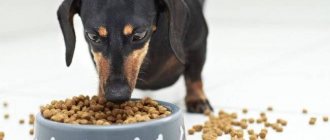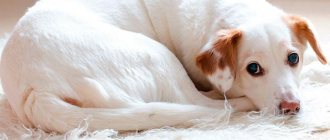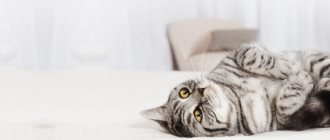Proud dachshunds, as they are called for the majestic expression of their faces. The legendary burrow hunters, with a powerful body and short powerful paws, have firmly won their place in the glorious hunting field and in the homes of non-hunting enthusiasts.
Bred in the 17th century in Germany for hunting burrowing animals, they ideally suit the main purpose of the breed. The original breed was a short-haired dachshund, whose parents were short pinschers and hounds.
Distinguished by their keen intelligence but stubborn nature, dachshunds do not require much training. All the instincts inherent in the breed by nature and breeders work perfectly without external interference. Previously, large breed dachshunds were used to hunt deer, but now they hunt foxes. Smaller breeds are indispensable in hunting rabbits and hares.
Dachshunds are good-natured and will quickly become favorites in families with children. They are devoted to their owners until their last breath and do an excellent job as a guard. They are very adaptable to different conditions, but due to their long body, it is not recommended to keep them in multi-story buildings, since the spine suffers with frequent climbing of stairs. The owner of the dachshund was Napoleon.
Dachshund division by size
There has long been a division of dachshunds by size into standard, rabbit and dwarf. In appearance, all varieties have a long, powerful body, an elongated snout, short and powerful legs designed for digging holes, soft floppy ears and a drooping tail.
This division is made based on such characteristics as height at the withers and weight of the dogs.
Standard fees
Long-bodied dogs with large, crooked legs and well-defined muscles. The height of standard cables reaches more than 35 cm at the withers. Weight can be up to 9 kg, but can reach 14 kg. There is one more parameter - chest volume, which in standard dogs is 35 cm or more.
Dwarf dachshund
Dwarf dachshunds are specially bred to hunt small animals such as rabbits, ferrets, and hares. Like any small dogs, very inquisitive, but slightly cowardly. In appearance they do not differ from standard representatives, but of course they differ in size. Its height at the withers is up to 30-35 cm, and its chest circumference is quite large - 30-35 cm. The dog's weight usually rarely exceeds 5 kg.
Rabbit dachshund
Miniature or rabbit dachshund, the smallest representative. The latest type of the breed, bred from crossing with representatives of the toy terrier and the small pinscher. It is considered more of a decorative dog than a hunting dog. Like other varieties, it differs only in parameters. In appearance it is similar to standard-sized dachshunds; rather, it is a smaller copy of them. Height at the withers is no more than 30 cm. Weight is small, usually not exceeding 3.5 kg.
For all varieties of dachshunds, a single standard in appearance has been defined: a head with a flat forehead and a convex nape, an elongated muzzle, narrow towards the nose. The ears should touch the cheekbones. The eyes are regular oval in shape, always brown in color, the nose is black or brown. The body is powerful with pronounced muscles and a long neck. The legs are strong and short, and the tail is slightly sharp at the tip.
The lifespan of all types of dogs is about 15 years.
Spaniels
Description
A group of hunting dog breeds, descended from medieval Spanish dogs, whose purpose was to hunt game birds from dense thickets. Currently, spaniels are divided into those who hunt on land and the so-called “water ones”.
All spaniels share common characteristics of the breed - long ears and, as a rule, soft and silky, straight, wavy or even curly hair.
Most spaniels are short in stature. Only the Irish Water Spaniel, which measures 51-59 cm, can be considered a large breed.
Separation by coat
The indefatigable imagination of breeders and breeders divided the breed into varieties based on their coat. Today, dogs are distinguished with three different coats: smooth-haired, wire-haired and long-haired.
The most ancient are smooth-haired representatives, with fur that fits tightly to the body. The short fur is so densely packed on the animal’s body that it shimmers in different colors in the sun, shimmering like gloss. Thick and short hair perfectly protects the dog’s skin from dirt and extreme wetness.
Wirehairs have a very hard coat. And under the top coat there is a dense undercoat. A touching feature of wire-haired dogs is a small beard and mustache and eyebrows, making pets, even puppies, look like aged sages.
The long-haired dachshund is the shaggiest of all species. Soft wool, as if slightly curled in curlers, very pleasant to the touch, shiny and silky. The standard does not allow excessive curling, so representatives of this species often have straight but long hair. Certain parts of the body, such as ears, tail, hind legs, are covered with hair more densely.
Separation by color
Dachshunds are divided not only by size and type of coat, but also by color.
The classic color of the dachshund, known throughout the world, is black and red. It comes in solid, marble, tan and brindle. The wire-haired species has a color called “boar” or simply gray. Single-colored red dogs are compared to deer for their nobility of color. In species with a solid color, black tips on the coat are allowed.
Marble color is distinguished by a blurring of spots on the main color, beige and gray. This color is characterized by black or brown claws and nose.
The brindle color is considered very rare. The peculiarity is the striped color, usually on a red or yellow background.
The isabella color is considered prohibited. Described as a bleached brown color. Dogs of this color suffer from skin diseases, and their immunity is greatly reduced.
Boys and girls dachshunds. External differences
The external differences of dogs are standard. The sex of a puppy can be distinguished by its sexual characteristics. In a male dog, the organ is located at a certain distance from the anus and the testicles are visible, while in females the organ resembles a heart and is located close to the anus.
Females are slightly more modest in size, but girls are not much smaller than boys, and must fit into the standards for height and length. Thus, a dwarf female at the withers is only 14-19 cm. The weight is also much less than that of males, they are more refined, the head size is smaller, and the body is more collected and toned.
Crossbreeds and mestizos
Breeders involved in crossing dogs never stop there. The dog breed we are considering is itself a derivative of two different breeds, this was written about in the article above. Several divisions by size, type of coat and color, it would seem, what else can you come up with with this breed of dog.
In fact, there are many dachshund mixes that come from crossing with different breeds. They all have their own characteristics, but the article discusses several of the most popular crosses.
Dachshund and spaniel
Everyone knows the distinctive features of the spaniel: long ears, curly hair, short stature. Crossing these two breeds produces offspring with traits more similar to a spaniel than a dachshund, but the puppies have a long body, more reminiscent of a dachshund's body. In character, the mestizo is more reminiscent of its restless hunter parent than a melancholy spaniel.
Dachshund and Jack Russell
A small dog, very active and cannot stand being alone. The color is similar to a Jack Russell, and he inherited his muscular and strong body from his second parent.
Spitz mix
A small fluffy Spitz, with mischievous eyes and fluffy fur, similar to a little bear cub, crossed with a dachshund, giving birth to a touching little dog. The body of a dachshund is strong and its size, intricately overgrown with Spitz hair, this is exactly what this cross looks like. Metis is overly active and will not let his owner get bored. Inherited hunting pride and stubbornness, and is difficult to train.
Beagle mix
The Beagle is a medium-sized dog adapted for hunting wild animals. Crossing two excellent hunters can result in an even more improved hunter. The harmonious combination gave this mestizo a shorter body than a dachshund, longer and more graceful legs, and the coat remained tight to the body and smooth. The hunting activity of one parent goes well with the good nature and sedateness of the beagle.
6) Bull Terrier
The comical head of this breed, which looks like a huge egg, can give the wrong impression of bull terriers. The history of the breed is similar to the history of the pit bull - these dogs were used for bloody battles. Bull Terriers are particularly good at killing rodents. They were thrown into rat-infested pits, where they could kill a dozen rodents at once. Today, dogs of this breed are much calmer and kinder than before, but still have the gladiator genes of their ancestors. If the owner does not train his pet correctly, the bull terrier can become domineering and aggressive towards other dogs and animals, as this is part of his character. These dogs are susceptible to diseases such as deafness and obsessive-compulsive disorder.
Briefly about the main thing
- A very smart dog, but stubborn and often restive. Will not follow the owner's commands thoughtlessly. Independent. Makes decisions with lightning speed.
- A real brave hunter, despite her small stature, she can deftly get any prey out of a hole.
- A playful and loyal dachshund, an excellent companion for life in urban environments, but owners need to take into account that proximity to smaller animals (ferrets and other rodents) will lead to irreversible consequences, since the hunting instinct of these dogs never sleeps. They can't stand cats.
- She loves to sleep in her owner's bed, as she was previously used to warm cold beds. This habit is instilled at the genetic level, and you will have to fight it.
- Despite the strong constitution and good health, this breed has its weaknesses.
- The long body imposed a number of prohibitions. Jumping from a height, even a small one, is undesirable. You should not be allowed to stand on your hind legs and lift them by the scruff of the neck. Due to the long spine, such actions can lead to deformation.
- Puppies need to be walked frequently.
- The owner needs to carefully monitor the pet’s eyes and prevent the accumulation of secretions.
- This breed is prone to obesity. You need to carefully monitor your diet.
- A cheerful, restless dog, thanks to frequent walks and mobility, can bring its owner into excellent physical shape. A brave heart, combined with a sharp mind and devotion, will make her an indispensable pet in a home where small children live.
Poodle
One of the most popular dog breeds in the world, it ranks second in the ranking of the smartest breeds after the border collie. Despite the prevailing opinion that the poodle is an exclusively female dog, representatives of this individual are strong and athletic. The Poodle is a breed of dog within which there is a significant criterion of difference - height. Large poodles require a large area for walking. They can be used as a service dog or a gun dog when hunting for aquatic game. Medium Poodles are used as lap dogs and are easier to care for. Toy poodles are quite hardy and run well. Representatives of this breed are very attached to people. Their life is focused on the owner and his family. They don't shed at all. However, the owner may have difficulty caring for their beautiful curls. To keep their coat in good condition, poodles need to be bathed every two or three weeks and trimmed regularly.
- Poodle puppies start at $50.
